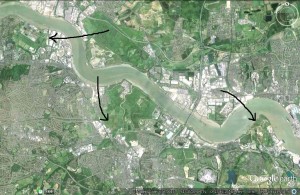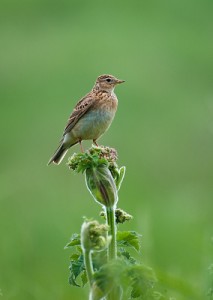SAVE OUR SKYLARKS – DON’T LET THE COUNCIL BOOT THEM OUT OF BEXLEY!
The future of the Skylark as a breeding bird in Bexley, and the survival of the Corn Bunting both here and in London as a whole – both of which species are red-listed due to major declines – will be in the hands of Bexley Council over the next couple of months as planning applications threaten key habitat both at Crossness on Erith Marshes, and on Crayford Marshes. In a triple whammy, the Council is also in discussion with the company seeking to destroy a large part of Swanscombe Marshes to make way for a theme park, as it sees this as a driver for even more ‘development’ in the north of our own Borough.
We will be calling on ‘BW’ followers to oppose these schemes. They will further diminish our wide open spaces, negatively impact endangered species and further impoverish biodiversity as a whole, counter to both national and Bexley Council policies and are unnecessary. More detail will be provided on each site in future postings.

What little remains of our inner Thames marshland on the south bank of the river – at Erith (Crossness), Crayford and Swanscombe Marshes (black arrows) – is threatened with further loss of habitat for endangered species.
At Crayford Marshes, a renewed planning application for a huge ‘logistics hub’ was due to be submitted to Bexley Council this month. If approved this will destroy a substantial part of the southern section, classified in the Sites of Importance for Nature Conservation review as Crayford agricultural and landfill, which is Metropolitan Open Land. Both Bexley and Dartford Councils opposed the original application, which was turned down, but permission was granted on appeal to the Government. The previous owners of the site, Prologis, failed to commence the development within the five years allowed, and have sold up to an outfit called Roxhill which is reheating the proposal. Freight on rail sounds all very nice and ‘sustainable’, but the reality is that this is essentially a speculative scheme that’s about shunting ever more ‘stuff’ around the country and around the globe, is most likely going to result in a net increase of heavy lorry movements in Bexley and has nothing to do with reducing carbon emissions or resource consumption to truly sustainable levels, quite the opposite.
A condition of the original scheme was that monies would be made available for managing what was left of the rest of the marshes, but this is robbing Peter to pay Paul, with the logical outcome of basing conservation policy on such thinking being very little wildlife habitat left in Bexley at all.
The 2013 SINC review document says: ‘The extensive area of the site and its proximity to two Sites of Metropolitan Importance (Crayford Marshes and the River Thames) further increase its value.’ Indeed when taken together with the SINC cited as Crayford Marshes, of which it is geographically and functionally a part, it forms the largest such site in the Borough. Moreover, when taken in conjunction with neighbouring Dartford Marshes, the area delivers an expanse of open space and big skies no longer available anywhere else in Bexley. The 2010 Lawton Review of UK nature conservation policy made it clear that bigger, better-connected sites are required, not more diminution and fragmentation.
The SINC review recognised that this lower part of Crayford Marshes is ‘used as a high-tide roost for gulls, redshank [amber-listed], curlew [amber], lapwing [red] and ringed plover [amber], and supports breeding skylark [red] and corn bunting [red] and large numbers of finches in winter.’
According to Bexley Bird Report compiler Ralph Todd, some 230 Skylarks were counted on the former landfill area in December 2010, but very few birds still breed in Bexley. Indeed Skylarks now hang on as a breeding bird in Bexley only on agricultural land near Chalk Wood (status unknown), as a pair or two at Upper College farm where dogs running off-leash and human disturbance are threats to this ground-nester and at Crayford Marshes and Crossness where access restrictions give them a chance of rearing young successfully. The ‘Birds of London’ (2014) had Corn Bunting down to 20 pairs in the whole of the capital, whilst the 2013 London Bird report recorded it from six sites, down from 11 the year before, and apparently in inexorable decline. Our information is that Corn Bunting is now breeding within the boundary of the proposed ‘development’ area.

The future of the Skylark in Bexley is threatened by proposed ‘development’ at Crayford Marshes and at Crossness, where this individual was pictured. (Photo: Dave Pressland, with permission)
Furthermore, we understand that Cory Environmental are submitting a planning application, before Christmas, proposing industrial development on the Cory/Borax fields at Crossness Nature Reserve, which lie either side of the Norman Road vehicle access road. These fields are within the gated boundary of what’s left of Erith Marshes, and are a key part of this fantastic habitat as far as the wildlife is concerned.
‘Development’ here will have devastating consequences for the nature reserve, not least because it simply could not be any closer. The north field will bound the nature reserve on 3 sides, and the field south of the access track will bound it (and water vole-populated ditches) on 2 sides. The proposed development will put the entrance to the nature reserve smack bang in the middle of an unsightly industrial area if, indeed, continued access is permitted. More crucially, these maturing former brownfield areas (now valuable open mosaic habitat) have breeding Ringed Plover and Skylark upon them. Little Ringed Plover have been seen on them also with a chick seen, and photographed, this year. This year the Barn Owls chose to breed in the pole-mounted nest box in the Norman Road Field, perilously close (approx. 200m) to the proposed development areas. The very rare Shrill Carder Bee was discovered at Crossness in 2014. There are only 7 UK populations, of which the Thames Corridor (and thus, Crossness) is one. Given that they are brownfield specialists, the probability of them breeding on the Cory/Borax Fields is incredibly high. Indeed the London Plan has a target for provision of such habitat.
Building on these fields will also add to the increasingly hemmed in feel of what is left of Erith Marshes, which have been repeatedly chipped away at in recent years, with no attempt made to give anything back to nature where older industries have closed down and an opportunity has arisen to rebuild the size this fantastic site.
In a recent letter in response to a question from Bexley Natural Environment Forum, Councillor Peter Craske hinted that these fields may have been proposed for inclusion within the Erith Marshes SINC boundary but were edited out of the SINC review draft. Clarification is being sought. Moreover, there was a condition attached to the incinerator development that they should be returned to their original condition. If that had been enforced and they had been restored to grazing marsh, they probably would be inside the boundary by now.
Cynics will also note that the Crossness (Erith Marshes) and Crayford Marshes planning applications are being submitted shortly before Christmas, and will recall that although Cllr. Craske has still not given a precise sign-off date on the SINC review, it looks increasingly likely that it will be after these applications are considered. The review recommends Crayford agricultural and landfill for promotion from a Grade 2 to a Grade 1 site.
Meanwhile ‘BW’ bets its money on the Crossness proposal being yet another dreary, unimaginative and inappropriate plan for more big warehouses at a time when Council officers have lamented the low jobs per square metre of such ‘developments’, whilst admitting that there is now a very real conflict between space ‘required’ for the Council’s plan to increase the housing allocation from 4,500 to 22,000 and the land area it thinks it needs to hit its own job targets.
Further unsubstantiated claims by Bexley’s planning department that there will be no loss of biodiversity, or even somehow a gain from these schemes will be unacceptable. They must be backed with reference to peer-reviewed evidence, must be testable and there must be conditions attached to any approvals to ensure long-term monitoring in order to prove outcomes one way or another. As things stand the Council can keep claiming with impunity that building on large chunks of SINC is compatible with its policy protecting and enhancing biodiversity in the Borough, the reason being that the measures of biodiversity it is referring to are not specified and no follow-up measurements are made. Common sense says that such claims are so unlikely to be true as to be knowingly misleading.
Doubtless the Council will also seek to hide behind ‘mitigation’. We might conceivably hear talk of green or brown roofs, but there is very limited evidence of birds breeding on these globally, and only a few instances in Britain. Both Skylark and Lapwing have bred on a green roof in Britain, but in any case Bexley Council has completely failed to implement its policy in favour of green or brown roofs on industrial developments by the Thames. The reality is that there will be a net loss of known suitable habitat for bird species of significant conservation concern at both Crayford Marshes and Crossness if these ‘developments’ are approved. If Bexley Councillors don’t care, they should say so, and not pretend otherwise.
Swanscombe Marshes has been substantially reclaimed from ‘brownfield’ by nature, with recent records including Bearded Tits, Ravens, Marsh Harriers, Short-eared Owls, Grey Grey Shrike, Skylark, Whinchat, Curlew and Yellow Wagtail. It is an important stepping stone towards Rainham on the Essex bank and our own Crayford and Erith Marshes. Depressingly, but not unexpectedly, Leader Teresa O’Neill (Ordering Building Everywhere) signalled Bexley Council’s interest in this fabulous site disappearing under a mickey mouse theme park at November’s full Council meeting, reporting that she had personally met with proponents Paramount. Why? Because it fits with the Council’s ‘growth strategy’ fixation in which the theme park will help drag Crossrail east to Ebbsfleet, at which point Bexley will be lobbying for services to stop also at Belvedere, Erith and Slade Green. Thus will promises of ever more ‘infrastructure’ to go with Ms. O’Neill’s plan for ever more housing be delivered.
We suggest that the physical and mental well-being (i.e. real wealth) of Bexley residents will best be served into the future by ensuring that we can continue to access and enjoy large open spaces with at least some vestige of a wilderness feel to them, and a protected and enhanced nature in our own Borough – including the iconic song of the soaring Skylark – and not by encouraging even more disconnect from the real world in some theme park in Swanscombe, playing games little different from what can probably be run on the TV at home.
Chris Rose
